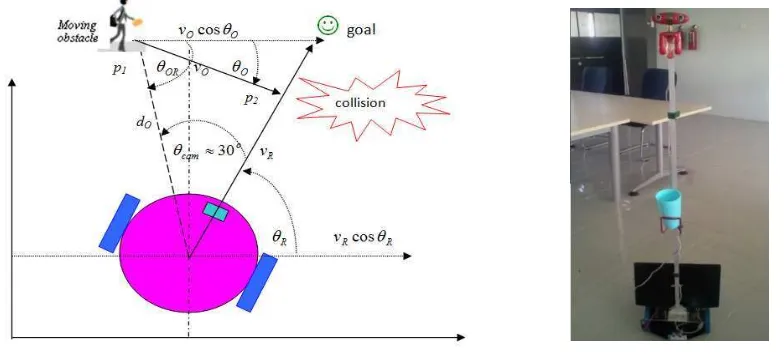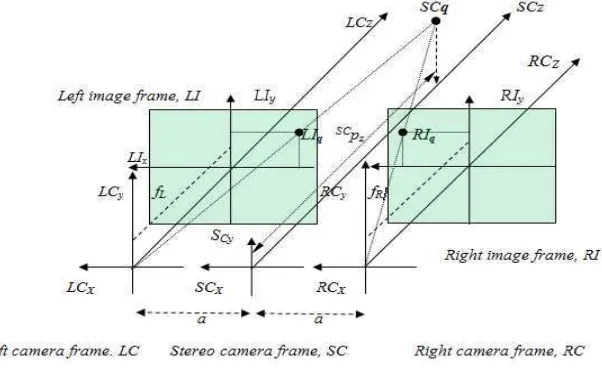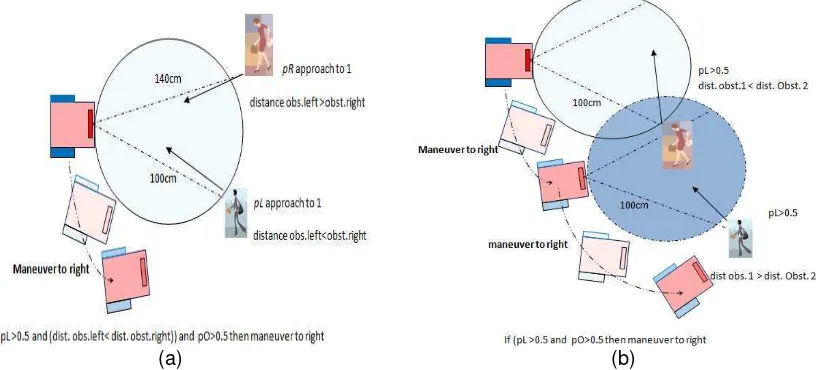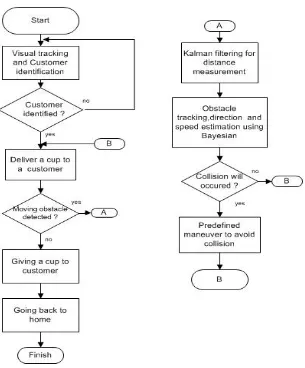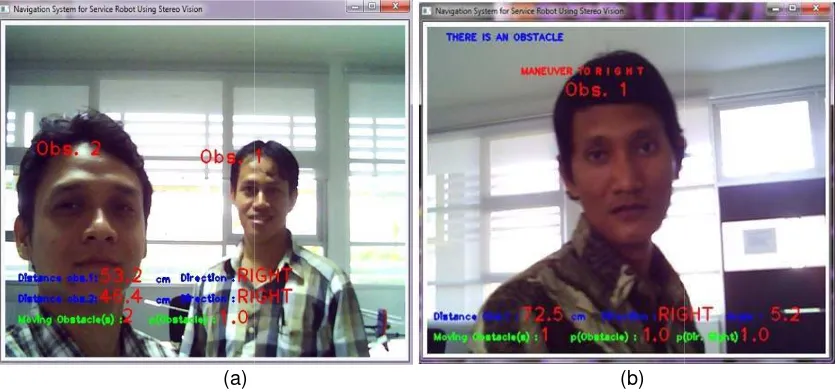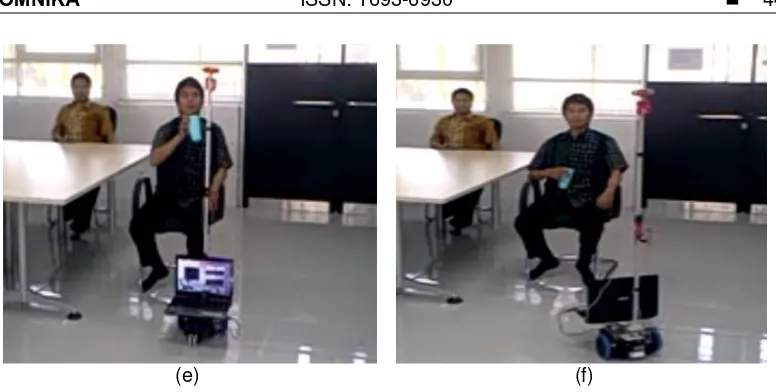ISSN: 1693-6930
accredited by DGHE (DIKTI), Decree No: 51/Dikti/Kep/2010 433
Received June 16th, 2011; Revised August 2nd, 2011; Accepted August 16th, 2011
Multiple Moving Obstacles Avoidance of Service Robot
using Stereo Vision
Widodo Budiharto*, Ari Santoso, Djoko Purwanto, Achmad Jazidie Electrical Engineering Department, Institute of Technology Sepuluh Nopember (ITS)
Kampus Sukolilo, keputih – Surabaya, Indonesia
e-mail: [email protected], [email protected], [email protected]
Abstrak
Pada paper ini, kami mengusulkan sistem penghindaran halangan ganda (multiple moving obstacles) menggunakan stereo vision untuk service robot yang berada di lingkungan indoor. Kami menganggap model service robot ini digunakan untuk mengirimkan sebuah gelas ke pelanggan yang dikenal dari titik asal ke titik tujuan. Kontribusi dari penelitian ini ialah sebuah metode baru untuk penghindaran multiple moving obstacle dengan pendekatan Bayesian berbasis kamera stereo. Kami telah mengembangkan dan memperkenalkan 3 modul utama untuk mengenal wajah, mengidentifikasi multiple moving obstacles dan untuk manuver robot. Sekelompok orang yang berjalan di depan robot akan ditrack sebagai moving obstacles, serta kecepatan, arah dan jarak dari moving obstacles diestimasi menggunakan kamera stereo agar robot dapat bermanuver untuk menghindari tubrukan. Untuk mengatasi ketidakakuratan dari sensor vision, pendekatan Bayesian digunakan uintuk estimasi keberadaan dan arah moving obstacle. Hasil eksperimen dipaparkan dan kami evaluasi performa dari sistem service robot yang diberi nama Srikandi III. Berdasarkan eksperimen, metode yang kami usulkan berjalan dengan baik serta pendekatan Bayesian terbukti meningkatkan performa estimasi dari keberadaan dan arah halangan.
Kata kunci: multiple moving obstacles, obstacle avoidance, service robot, stereo vision
Abstract
In this paper, we propose a multiple moving obstacles avoidance using stereo vision for service robots in indoor environments. We assume that this model of service robot is used to deliver a cup to the recognized customer from the starting point to the destination. The contribution of this research is a new method for multiple moving obstacle avoidance with Bayesian approach using stereo camera. We have developed and introduced 3 main modules to recognize faces, to identify multiple moving obstacles and to maneuver of robot. A group of people who is walking will be tracked as a multiple moving obstacle, and the speed, direction, and distance of the moving obstacles is estimated by a stereo camera in order that the robot can maneuver to avoid the collision. To overcome the inaccuracies of vision sensor, Bayesian approach is used for estimate the absense and direction of obstacles. We present the results of the experiment of the service robot called Srikandi III which uses our proposed method and we also evaluate its performance. Experiments shown that our proposed method working well, and Bayesian approach proved increasing the estimation perform for absence and direction of moving obstacle.
Keywords: multiple moving obstacles, obstacle avoidance, service robot, stereo vision
1. Introduction
program using vision sensor will make a service robot have the ability to detects and identifies detailed object around it (such as face recognition, distance measurement of obstacle, and free area for path planning). The main concern when develop a service robot is obstacle avoidance system and the implementation of stereo camera as an important vision sensor. Although vision-based service robot become the chalenging and complex task for research and engineer, models of the multiple moving obstacle avoidance system for vision-based service robot using Bayesian approach for state estimation is not explored extensively.
The development of an obstacle avoidance system for service robot to accurately detect moving obstacles in indoors is challenging task. The navigation and obstacle avoidance strategy are the important aspects in a vision-based service robot. Bayesian techniques provide a powerful statistical tool to help manage measurement uncertainty and perform multisensor fusion and identity estimation. The advantages of probabilistic robotics are able to accommodate imperfect sensors (such as camera with noises), robust in real world applications and best known approach to many hard robotics problem. Using sensory information to locate the robot in its environment is the most fundamental problem to providing a service robot with autonomous capabilities. By using Bayesian approach in robot system, the state of presence of obstacles and other properties can be estimated.
Based on literatures obtained by the authors, many research in development of service robot such as [1], [2], whereas task of the service robot is the setting and clearing of tables in a controlled environment without stereo camera. However, there is no multiple moving obstacles avoidance method for service robot in indoor environment exposed especially using stereo camera. The contribution of this paper is the introduction of a new method of multiple moving obstacles avoidance for service robots using a stereo camera in indoor environment. In this paper, we solved the drawbacks of common obstacle avoidance methods such as Potential Field Method (PFM) [3] and Vector Field Histogram (VFH) [4] by proposed a complete mechanism for multiple moving obstacles avoidance of vision-based service robot.
2. Research Method
2.1 Architecture for Service Robot
A mobile robot involving two actuator wheels is considered as a system subject to nonholonomic constraints and usually using fuzzy logic to control the motor [5]. Consider an autonomous wheeled mobile robot and position in the Cartesian frame of coordinates shown in Figure 1, where ݔோ and ݕோ are the two coordinates of the origin P of the moving frame and ߠோis the robot orientation angle with respect to the positive x-axis. The rotation angle of the right and left wheel denoted as ߮ and ߮ and radius of the wheel by R thus the configuration of the mobile robot qRcan be described by five generalized coordinates such as:
T l r R R R
R
x
y
q
=
(
,
,
θ
,
ϕ
,
ϕ
)
(1)Based on Figure 1, ݒோ is the linear velocity, ߱ோ is the angular velocity, ݎோ andߣோ are radial and angular coordinate of the robot [6]. The kinematics equations of motion for the robot given by:
R R
R
v
x
&
=
cos
θ
(2)
R R
R
v
y
&
=
sin
θ
(3)
R
R
ω
θ
&
=
(4)
The angular velocity of the right and left wheel can be obtained by:
dt
d
rr
ϕ
ω
=
and
dt
d
ll
ϕ
ω
=
(5)
Multiple Moving Obstacle Avoidance for Service Robot using Stereo Vision (Widodo Budiharto)
2
/
)
(
r lR
R
v
=
ω
+
ω
(6)
Figure 1. Cartesian representation of mobile robot
Based on the model in Figure 1, we propose the model of a mobile robot using a stereo
camera with a moving obstacle as shown in Figure 2. A camera as a vision sensor has limitations in view angle to capture an object, so we define
θ
Cam as a maximum angle that moving obstacles can be detected by a camera used in this research.Figure 2. General cartesian model of mobile robot using stereo camera
Figure 3. Prototype of Service robot Srikandi III using Stereo Vision.
We have developed a vision-based service robot called Srikandi III with the ability to face recognition and avoid people as moving obstacles, this wheeled robot is next generation from Srikandi II [7], [8]. The prototype of service Robot Srikandi III that utilized a low cost stereo camera, 1 ultrasonic sensor, compass and Propeller 32 bit microcontroller in order the cost of development can be reduces is shown in Figure 3.
2.2 Improved Face Recognition System using PCA 2.2.1 Stereo Imaging Model
stereo imaging model, the tree-dimensional points in stereo camera frame are projected in the left and the right image frame. On the contrary, using the projection of the points onto the left and right image frame, the three-dimensional points positions in stereo camera frame can be located. Figure 4 shows the stereo imaging model using the left front image frame LF and right front image frame RF [9].
Figure 4. Stereo Imaging mode
By using stereo vision, we can obtain the position of each moving obstacle in the images, then we can calculate and estimate the distance of the moving obstacle. Kalman filtering used for the stability of the distance estimation. The three-dimensional point in stereo camera frame can be reconstructed using the two-dimensional projection of point in left front image frame and in right front image frame using formula :
(7) Note that y RI y LI
q
q
=
To estimate the direction θdirection of moving obstacle using stereo vision, we calculate using the figure and formula below:
Figure 5. Direction estimation using stereo vision
Multiple Moving Obstacle Avo θdirection =arc tan ቀ௱
௱ೣቁ
2.2.2 Improved Face Recog The face is our prima serves peoples. Unfortunatell difficult, because faces are co of face images can be based [10] and Linear Discriminat assumption of certain surfac Discriminant Analysis (LDA) is best separates two or more c system and faces database Indian face database. The a customer in .xml file and disp construct images under diffe brightness level for ITS face d face. Each set of ITS face d illumination[13].
Figure 6. ITS, Indian and
2.3 A Moving Obstacles Avo 2.3.1 Probabilistic robotics
Camera as vision sen to state estimation and dete sensor data. Bayesian deci noisy observations. Examples x is a quantity that we would probability distribution. The Ba p(x, y) whenever a new observ
,
|,|
voidance for Service Robot using Stereo Vision (W
ognition System
ary focus of attention in developing a vision based elly, developing a computational model of face re complex, meaningful visual stimuli and multidimen
d on statistical model such as Principal Componen at analysis (LDA)[11][12] and physical modellin face reflectance properties, such as Lambertian ) is a method of finding such a linear combination o e classes[9]. We have developed a framework for se called ITS face database and will be compare advantages of our framework is able to store o isplayed on the screen as shown in Figure 10. In ifferent illumination conditions by generate a ra e database. Each of face database consists of 10 database consists of 3 poses (front, left, right )
(a)
(b)
(c)
nd ATT face database used as comparison to see illumination at face recognition [13].
voidance Method using Bayesian Approach s for Multiple Obstacle Avoidance Method ensor sometimes have distortion, so Bayesian dec
termine the optimal response for the robot base ecision rule probabilistically estimate a dynamic s
les of measurement data include camera images a ld like to infer from y, the probability p(x) will be re Bayesian update formula is applied to determine
ervation is obtained:
|
Widodo Budiharto) (8)
sed service robot to recognition is quite ensional. Modelling nent Analysis (PCA) lling based on the n surface. Linear n of variables which for face recognition ared with ATT and ordered item from In this research, we random value for 10 sets of people’s t ) and varied with
ee the effect of
ecision theory used ased on inaccurate system state from s and range scan. If referred to as prior e the new posterior
To apply Bayesian approach for obstacle avoidance where someone who walks with a direction indicated as an unexpected obstacle, we consider this obstacle to be a random event. The probabilistic information in z about
θ
is described by a conditional probability density functionp
(
z
|
θ
)
of the observation vector z. LetΘ
denote the state of the path to be a random variable consisting of four states:)
,
,
,
(
θ
1θ
2θ
3θ
4=
Θ
(10)=
(
obstacle
,
no
_
obstacle
,
direction
_
right
,
direction
_
left
)
If we want a service robot should stay on the path to goal in any case, strategies to avoid moving obstacle include:
• Maneuver to the right, if detected moving obstacle is moving toward the left. Maneuver to the left, if detected moving obstacle is moving toward the right.
• stop, if moving obstacle too close to robot detected both by vision and ultrasonic sensors.
Then, we restrict the action space denoted as A as:
)
,
(
a
1,a
2a
3=
Α
(11)= maneuver to right, maneuver to left, stop
We define a loss function L(a, θ) which gives a measure of the loss incurred in taking
action a when the state is θ. The robot should chooses an action a from the set A of possible
actions based on the observation z of the current state of the path θ. This gives the posterior distribution of θ as:
∑
=
)
(
)
|
(
)
(
)
|
(
)
|
(
θ
θ
θ
θ
θ
p
z
p
p
z
p
z
p
(12)Then, based on the posterior distribution in (12), we can compute the posterior expected loss of an action [14]:
∑
=
θθ
θ
θ
|
),
)
(
,
)
(
|
)
(
(
p
z
a
L
a
p
z
B
(13)2.3.2 Proposed Multiple Moving Obstacles Avoidance Method and Algorithm
We have proposed a method and algorithm of obstacles avoidance for service robot that run from start to goal position, giving a cup to customer and going back to home. This method will identify a customer, checking moving obstacles and its distance and take action for maneuver to avoid the collision. Stereo camera used has limitation such as angle view, this camera only able to capture object infront of it about 30°. So, when the robot starts to maneuver, the moving obstacle could be out of view area of camera. So for this experiment, we have proposes a predefined motion for maneuver based on the estimation speed and direction of moving obstacle.
Table 1. Actions to avoid moving obstacle
No Speed of moving obstacle Direction of moving obstacle Action
1 Low Approach to robot Manuver slow
2 High Approach to robot Maneuver fast
3 Low Infront of robot Manuver slow
4 High Infront of robot Manuver slow
Multiple Moving Obstacle Avoidance for Service Robot using Stereo Vision (Widodo Budiharto) leads to the right. By estimating the direction of motion of the obstacle, then the most appropriate action to avoid to the right / left side can be determined, to minimize collision with these obstacles. If there are more than 1 moving obstacle, then robot should identified the nearest moving obstacle to avoid collision, and the direction of maneuver should be opposite with the direction of moving obstacle (Figure 7).
(a) (b)
Figure 7. A maneuvering model to avoids multiple moving obstacle using stereo vision, 2 multiple moving obstacle with the different direction (a) and the same direction (b).
The flowchart of a Navigation system and multiple moving obstacles avoidance method for vision-based service robot using stereo camera shown in Figure 8. Based on the Figure 8, image captured by stereo camera used as testing images to be processed by Haar classifier to detect how many people in the images, and face recognition by PCA. We implement visual tracking for heading a robot to a customer. Robot continuously measures the distance of obstacle and send the data to Laptop. The next step is multiple moving obstacle detection and tracking. If there is no moving obstacle, robot run from start to goal position in normal speed. The advantage using stereo vision in our system is the ability to estimate the distance of customer/obstacles (depth estimation) and direction’s movement of obstacles.
If moving obstacle appeared and collision will occurred, robot will maneuver to avoids obstacle. The proposed algorithms for obstacles avoidance shown below:
Algorithm 1. Multiple moving obstacles avoidance and maneuvering for service robot. Checking a cup sensor // check if cup is loaded or no
Capture face’s images
Face detection and recognition using PCA if cup loaded and face recognized // Visual tracking using stereo vision While (customer !=center screen)
begin
Heading robot to customer’s position end
if (position of customer at center screen) begin
Go to customer
call movingObstaclesIdentification Bayesian processing
if moving obstacle==true and min_distance=true and goal=false maneuvering the robot
end if
end end if end
// Function to detects and tracks a moving obstacle function movingObstacleIdentification
moving obstacle detection // Using Haar cascade classifier if (moving_obstacle==true) then
//estimate distance between robot and moving obstacle using stereo vision distance estimation // Using Stereo camera and Kalman filtering // estimate velocity and direction of moving obstacle
Calculate
v
O , direction EndifReturn
v
O , direction end function
Figure 8. Flowchart of A Navigation system and Multiple moving obstacles avoidance method for vision-based service robot using stereo camera.
3. Results and Analysis
3.1 Improved Face Recognition System
Multiple Moving Obstacle Avo clearly that ITS database have the illumination of testing im method and ITS face databas execution time, it seems the image is lowest then ITS and A
(a)
Figure 9. Accuracy comparis
The result of improved succesfully identified with his robot to an identified custom proposed method.
Figure 10. An example of fr
3. 2 Multiple moving obstac The result of identifyin if we using stereo vision, we
voidance for Service Robot using Stereo Vision (W ave highest success rate than ATT and Indian fac images is varied. The success rate using PCA i ase is 95.5 %, higher than ATT face database 95 e Indian face database (IFD) is shortest because d ATT (b)[13]
(b)
arison of face recognition between 3 faces database sets face.
ed face recognition system shown in Figure 10, w is order. Before delivering a cup, visual tracking ap omer. Robot succesfully go to the identified cus
face detected and recognized together with his or framework of face recognition system.
acle avoidance using Stereo Vision.
ying multiple moving obstacle shown in figure below we can estimate the distance and direction/ang
Widodo Budiharto) ace database when in our proposed 95.4% (a). For total se the size of each
ases, each using 10
, where 1 customer applied to directs a customer using our
order using our
obstacle. The value probability more robust as as shown Figu
(a)
Figure 11. value probabili estimation, (b). implementatio
(a)
(c)
ility of obstacle/no obstacle also run well for make igure 11.
(b)
ility of obstacle/no obstacle, (a). results of distance tion of probabilistics robotics for moving obstacles
stereo images.
(b)
(d)
e a robotics system
Multiple Moving Obstacle Avoidance for Service Robot using Stereo Vision (Widodo Budiharto)
(e) (f)
Figure 12. Result of moving obstacle avoidance using stereo vision and Bayesian approach. Sequence action of service robot shown from (a) until (f) to deliver a cup to an identified
customer and go back to home.
For experiment delivering a cup to a customer, the setup experiment is in indoor where a customer and not customer sitted on the chair, and there is someone that walking as a moving obstacle as shown below. Robot succesfully identify a moving obstacle, avoid the collision, giving a cup to a customer then go back to home. For 10 (ten) times experiment using Bayesian approach, the success rate to identify moving obstaacle is 90%, and without Bayesian approach is 60%. The very insteresting video to show the action of this robot can be viewed at: http://www.youtube.com/watch?v=n181CtvGJ88.
4. Conclusion
This paper presents a robust multiple moving obstacles avoidance method for service robot in indoor environment. By varying illumination in training images, it will increase the success rate in face recognition. The success rate using our proposed method (ITS face database) is 95.5 %, higher than ATT face database 95.4%. Our framework of face recognition system can be used for the vision-based service robot. Geometrical model for moving obstacle avoidance and algorithms for multiple moving obstacles proposed then succesfully implemented to a service robot. Integration of stereo vision and ultrasonic sensors proved applicable as main sensors for distance estimation between service robot and obstacles. Experimental results with various situations have shown that the robot reaches the goal points while avoiding multiple moving obstacle with the proposed method. The state estimation using Bayesian used for absense and direction of obstacles increasing the succes rate of obstacle’s detection and measurement. Bayesian decision rule implemented for state estimation makes this method more robust because the optimal solution for avoiding obstacles is obtained by trading between maneuver and stop action. The strength of the visual tracking and maneuvering method proposed shown good performance for navigation system of vision-based service robot. This paper have contribution for solving the drawbacks of common obstacle avoidance methods by proposed a complete mechanism for multiple moving obstacles avoidance of vision-based service robot. For future work, we will focus on navigation system for humanoid service robot using stereo vision.
References
[1] Acosta L, González EJ, Rodríguez JN, Hamilton AF, Méndez JA, Hernéndez S, Sigut SM, Marichal GN. Design and Implementation of a Service Robot for A Restaurant. International Journal of robotics and automation. 2006; 21(4): 273-281.
[3] Chatib O. Real-Time Obstacle Avoidance for Manipulators and Mobile Robots. The International Journal of Robotics Research. 1986; 5(1): 90-98.
[4] Borenstein J, Koren Y. The Vector Field Histogram- Fast Obstacle Avoidance for Mobile Robots.
IEEE Trans. On Robotics and Automation. 1991; 7(3): 278-288.
[5] Widodo SW. Penerapan Multi Mikrokontroler pada Model Robot Mobil Menggunakan Logika Fuzzy.
TELKOMNIKA Indonesian Journal of Electrical Engineering. 2009; 7(3): 213-218.
[6] Masehian E, Katebi Y. Robot Motion Planning in Dynamic Environments with Moving Obstacles and Target. International Journal of Mechanical Systems Science and Engineering. 2007; 1(1): 20-29. [7] Budiharto W, Purwanto D, Jazidie A. A Robust Obstacle Avoidance for Service Robot using
Bayesian Approach. International Journal of Advanced Robotic Systems. 2011; 8(1): 52-60.
[8] Budiharto W, Purwanto D, Jazidie A. A Novel Method for Static and Moving Obstacle Avoidance for Service robot using Bayesian Filtering. Proceeding of IEEE 2nd International conf. on Advances in Computing, Control and Telecommunications Technology. 2010: 156-160.
[9] Purwanto D. Visual Feedback Control in Multi-Degrees-of-Freedom Motion System. PhD Thesis. Keio: Graduate School of Science and Technology - Keio University, Japan; 2001.
[10] Turk M, Pentland A. Eigenfaces for recognition. International Journal of Cognitive Neuroscience. 1991; 3(1): 71-86.
[11] Belhumeur P, Kriegman D. What is the set of images of an object under all possible illumination conditions. International Journal of Computer Vision. 1998; 28( 3): 245-260.
[12] Etemad K, Chellappa R. Discriminant analysis for recognition of human face images. Journal of the Optical Society of America A. 1997; 14( 8): 1724-1733.
[13] Budiharto W, Santoso A, Purwanto D, Jazidie A. An Improved Face recognition System for Service Robot using Stereo Vision. In: Tudor Barbu Editor. Face Recognition / Book 3. Austria: Intech Publisher; 2011: 1-12.
